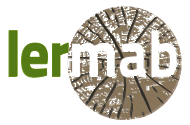- Président :
Patrick PERRÉ Professeur, LGPM - Ecole Centrale de Paris
- Rapporteurs :
Monika WOLOSZYN Professeur, LOCIE - Université de Savoie
Bernard PERRIN Professeur, LMDC - Université Paul Sabatier
Toulouse
- Examinateur :
Gérard JEANDEL Professeur, LEMTA - Université de Lorraine
- Directeur de thèse :
Yann ROGAUME Professeur, LERMAB - Université de Lorraine
- Co-directeur de thèse :
Éric MOUGEL Maître de conférences, LERMAB - Université de Lorraine
- Invités:
Philippe THIRIET Resp. Transfert Technologique, CRITT BOIS
Alexis NICOLAS Ingénieur, AVEN’R – Epinal
Coupled heat and moisture transfer through hygroscopic materials, particularly wood and wood-based products are difficult to model. This is partly due to some specific and complex properties of these materials that are often not included in numerical models. Currently, only a few numerical models are able to predict accurately the hygrothermal performance of wooden building envelope. The aim of this work is to assess the heat and moisture transfer in wooden building envelope through experiments and validate the prediction capacity of a numerical model developed to simulate hygrothermal behavior of envelope including wooden materials. After giving a theoretical reminder of the coupled heat and moisture transfer through building envelope and reporting the results of previous studies in this field, we will give details of the experimental investigation on heat and moisture transfer through timber walls. Firstly, the experimental apparatus used for the wall tests is presented. Then, we will analysis the hygrothermal performance of wooden walls provided by the partners of the TRANSBATIBOIS project in which this work was achieved. Experimental works achieved for Buildingpore model validation and results of the comparisons between experimental assessment and numerical predictions with Buildingpore and WUFI are also reported. The third part of this study deals with the experimental assessment of wooden building envelopes exposed to climatic conditions. An analysis of the hygrothermal performance and the energy consumption of wooden test-cells is performed and reported in this part. The latest part concerns experimental works on buildings.
